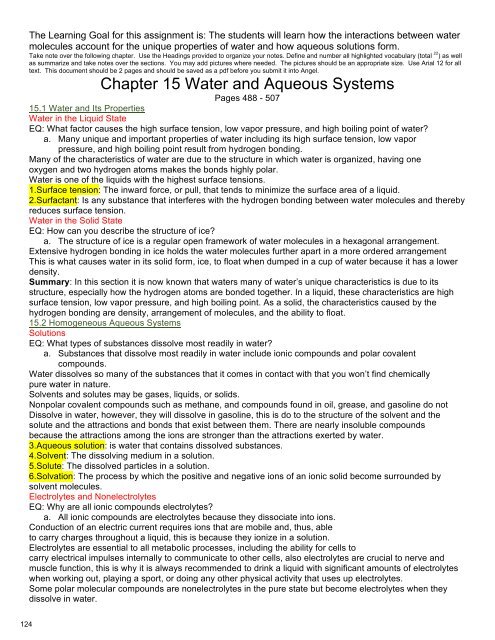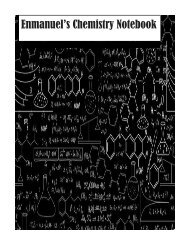Create successful ePaper yourself
Turn your PDF publications into a flip-book with our unique Google optimized e-Paper software.
The Learning Goal for this assignment is: The students will learn how the interactions between water<br />
molecules account for the unique properties of water and how aqueous solutions form.<br />
Take note over the following chapter. Use the Headings provided to organize your notes. Define and number all highlighted vocabulary (total 22 ) as well<br />
as summarize and take notes over the sections. You may add pictures where needed. The pictures should be an appropriate size. Use Arial 12 for all<br />
text. This document should be 2 pages and should be saved as a pdf before you submit it into Angel.<br />
Chapter 15 Water and Aqueous Systems<br />
Pages 488 - 507<br />
15.1 Water and Its Properties<br />
Water in the Liquid State<br />
EQ: What factor causes the high surface tension, low vapor pressure, and high boiling point of water?<br />
a. Many unique and important properties of water including its high surface tension, low vapor<br />
pressure, and high boiling point result from hydrogen bonding.<br />
Many of the characteristics of water are due to the structure in which water is organized, having one<br />
oxygen and two hydrogen atoms makes the bonds highly polar.<br />
Water is one of the liquids with the highest surface tensions.<br />
1.Surface tension: The inward force, or pull, that tends to minimize the surface area of a liquid.<br />
2.Surfactant: Is any substance that interferes with the hydrogen bonding between water molecules and thereby<br />
reduces surface tension.<br />
Water in the Solid State<br />
EQ: How can you describe the structure of ice?<br />
a. The structure of ice is a regular open framework of water molecules in a hexagonal arrangement.<br />
Extensive hydrogen bonding in ice holds the water molecules further apart in a more ordered arrangement<br />
This is what causes water in its solid form, ice, to float when dumped in a cup of water because it has a lower<br />
density.<br />
Summary: In this section it is now known that waters many of water’s unique characteristics is due to its<br />
structure, especially how the hydrogen atoms are bonded together. In a liquid, these characteristics are high<br />
surface tension, low vapor pressure, and high boiling point. As a solid, the characteristics caused by the<br />
hydrogen bonding are density, arrangement of molecules, and the ability to float.<br />
15.2 Homogeneous Aqueous Systems<br />
Solutions<br />
EQ: What types of substances dissolve most readily in water?<br />
a. Substances that dissolve most readily in water include ionic compounds and polar covalent<br />
compounds.<br />
Water dissolves so many of the substances that it comes in contact with that you won’t find chemically<br />
pure water in nature.<br />
Solvents and solutes may be gases, liquids, or solids.<br />
Nonpolar covalent compounds such as methane, and compounds found in oil, grease, and gasoline do not<br />
Dissolve in water, however, they will dissolve in gasoline, this is do to the structure of the solvent and the<br />
solute and the attractions and bonds that exist between them. There are nearly insoluble compounds<br />
because the attractions among the ions are stronger than the attractions exerted by water.<br />
3.Aqueous solution: is water that contains dissolved substances.<br />
4.Solvent: The dissolving medium in a solution.<br />
5.Solute: The dissolved particles in a solution.<br />
6.Solvation: The process by which the positive and negative ions of an ionic solid become surrounded by<br />
solvent molecules.<br />
Electrolytes and Nonelectrolytes<br />
EQ: Why are all ionic compounds electrolytes?<br />
a. All ionic compounds are electrolytes because they dissociate into ions.<br />
Conduction of an electric current requires ions that are mobile and, thus, able<br />
to carry charges throughout a liquid, this is because they ionize in a solution.<br />
Electrolytes are essential to all metabolic processes, including the ability for cells to<br />
carry electrical impulses internally to communicate to other cells, also electrolytes are crucial to nerve and<br />
muscle function, this is why it is always recommended to drink a liquid with significant amounts of electrolytes<br />
when working out, playing a sport, or doing any other physical activity that uses up electrolytes.<br />
Some polar molecular compounds are nonelectrolytes in the pure state but become electrolytes when they<br />
dissolve in water.




